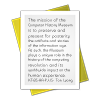Title
Ingalls, Daniel oral historyCatalog Number
102738237Type
DocumentDescription
Daniel H. H. Ingalls Jr. was born in 1944 in Washington, D.C. His father was a Sanskrit professor at Harvard who had worked for the OSS in WWII doing codebreaking. After graduating from Harvard with a degree in physics in 1966, Ingalls attended graduate school at Stanford studying electrical engineering. Motivated by learnings from a course taught by Don Knuth, Ingalls dropped out of graduate school to start a one-man company optimizing programs for local companies. In the course of his business he met George White, a speech recognition researcher at Xerox PARC, who invited Ingalls to join him there.Once inside PARC, Ingalls began to be more interested in the conversations taking place across the hallway, in Alan Kay’s office. Conversations with Kay led to a bet that Kay could design a programming language small enough to fit on a single page, which became Smalltalk-72. Ingalls quickly implemented Kay’s design in BASIC, and soon after wrote a version that would run on PARC’s Alto personal computer.
Ingalls ended up joining Kay’s Learning Research Group, becoming,the lead developer of a succession of Smalltalk iterations at PARC, including Smalltalk-74, 76, 78, and 80. Two key innovations were BitBlt (Bit Block Transfer), a widely adopted graphics primitive, and the byte coded interpreter, both implemented in the Alto’s microcode, allowing for these operations to take place quickly.
In 1979, Ingalls played a key role in demonstrating Smalltalk to a delegation from Apple, including Steve Jobs, introducing to him the graphical user interface and the advantages of live programming.
Around 1984/85, Ingalls decided to join Apple’s Advanced Technology Group to work on getting Smalltalk to run well on the Apple Macintosh. At Apple, Ingalls designed Fabrik, a visual programming language. After taking an eight-year break from the technology industry to help run the family hotel in Virginia, Ingalls returned to Apple in 1993, where he rejoined with Alan Kay to create Squeak, a portable, open-source version of Smalltalk-80 implemented in Smalltalk itself.
Soon after the release of Squeak, most of Kay’s group, including Ingalls, moved from Apple to Disney Imagineering, and the group created Etoys, a graphical educational programming environment implemented on top of Squeak. Etoys became an influence on the more widely adopted educational language Scratch, created at the MIT Media Lab.
A few years after leaving Disney in 2001, Ingalls ended up at Sun in 2005, writing a Java interpreter for Squeak that was later converted to JavaScript, leading to the Lively Kernel, a live programming environment that runs in a web browser. Ingalls continued to work on Lively Kernel after joining SAP in 2010, later spinning out into a research group that ended up with Y Combinator. In recent years, Ingalls has restored historical versions of Smalltalk, from 72 through Squeak, that run in the web browser on top of Lively Kernel.
Date
2017-04-10Contributor
| Hsu, Hansen, Interviewer |
| Ingalls, Daniel H., Interviewee |
Publisher
Computer History MuseumPlace of Publication
Mountain View, CAExtent
68 p.Format
PDFCategory
TranscriptionSubject
Smalltalk; Harvard University; Xerox PARC; Tektronix; HP; Apple; Disney Imagineering; Viewpoints Research Institute; SAP; Y Combinator; Knuth, Donald; White George; Kay, Alan; Goldberg, Adele; Kaehler, Ted; Merry, Diana; Robson, Dave; Deutsch, L Peter; McCall, Kim; Purcell, Steve; Fairbairn, Douglas; Tesler, Larry; Jobs, Steve; Atkinson, Bill; Meyers, Rick; Maloney, John; Wallace, Scott; Piumarta, Ian; Raab, Andreas; Ungar, Dave; Smith, Randy; Shoup, Richard; Edens, Glenn; Victor, Bret; Hart, Vi; Freudenberg, Bert; BitBIy; byte code interpreter; Alto; microcode; Squeak; Etoys; Lively KernelCollection Title
CHM Oral History CollectionCredit
Computer History MuseumLot Number
X8167.2017Related Records
| 102738238 | Ingalls, Daniel oral history |


